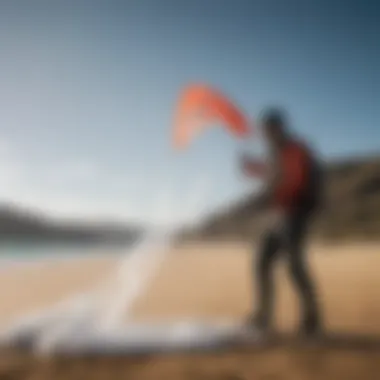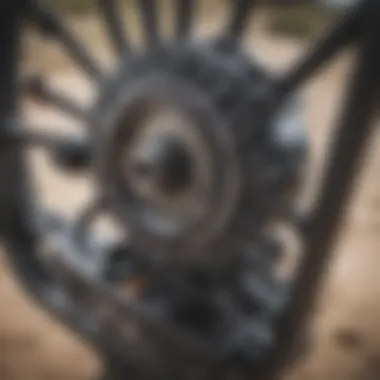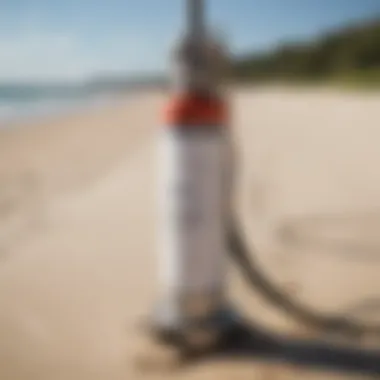Kite Pump Insights: Elevate Your Kiteboarding Skills


Intro
Kiteboarding is more than just a sport; it's an adventure that combines the thrill of gliding over water with the serenity of catching the wind. At the heart of this exhilarating experience is a seemingly simple yet crucial piece of equipment: the kite pump. Without a reliable pump, your kite may take a while to inflate or, worse, may never even leave the ground. This guide aims to unravel the mystique of kite pumps, delving into their technical facets and their indispensable role in enhancing your kiteboarding escapades.
In the landscape of kiteboarding gear, understanding your kite pump can set the tone for your entire day on the water. The right pump not only makes inflating your kite a breeze, but it also ensures that your kite performs at its best, helping you tackle the waves with confidence.
Throughout this article, we'll explore the different types of kite pumps available and how you can choose the best one for your needs. We’ll also delve into maintenance practices that can prolong the life of your equipment, and provide tips for making the most out of your gear.
Get ready to equip yourself with the knowledge to elevate your kiteboarding experience!
The Role of the Pump in Kiteboarding
When it comes to kiteboarding, the pump is not just a mere accessory; it’s an integral part of the entire experience. Kite pumps serve as the bridge between an inflated sail and water-bound thrill, making it essential to understand their role. A kite that’s properly inflated offers optimal performance, stability, and responsiveness in the air, enhancing the rider’s experience on the water.
Understanding Kite Inflation
Kite inflation may seem straightforward—just fill it with air and hit the waves, right? Well, not quite. The process actually goes beyond simply blowing up your gear. Each kite design has specific air chamber configurations that dictate how efficiently and effectively air fills the sail. For instance, a single-liner kite might need a slow, methodical pump action to fill properly, while a modern delta kite can often be inflated more quickly without compromising performance.
Understanding the nuances of kite inflation can make a significant difference in your ride.
Here’s an important take: the pump essentially shapes your kite’s profile, which in turn impacts your control and speed on the water. If the kite is under-inflated, it won't maintain its intended shape and can drop out of the sky at inopportune times; over-inflation, on the other hand, could lead to structural stress and potential damage. Hence, a keen understanding of kite inflation is crucial for all kiteboarders.
Significance of Proper Inflation Pressure
Getting the pressure just right is where the art of kite pumping comes into play. Think of it like making a perfectly balanced drink: too much sugar, and it’s cloyingly sweet; too little, and you can't taste it at all. The right amount of air pressure ensures that the kite maintains its optimal performance characteristics.
Proper inflation pressure also affects the kite’s handling. An adequately pumped kite reacts to steering input quickly, allowing for agile maneuvers that can make or break your ride. A kite that’s inflated correctly feels lively and responds positively to the slightest adjustments in direction, while under-inflation might leave you struggling to steer.
"A well-inflated kite isn’t just a pleasure to ride; it’s a safety feature, keeping you where you need to be on the water."
Moreover, proper inflation pressure significantly impacts the kite's durability. Kites that are frequently under-inflated are more likely to experience wear and tear, ultimately cutting short their lifespan. Conversely, a kite that’s consistently over-inflated can develop creases or even burst under extreme pressure. Consequently, understanding and maintaining proper inflation pressure isn’t just about performance; it’s a matter of preserving your investment.
In summary, the pump is a silent hero in the world of kiteboarding—its role in kite inflation and managing pressure shapes not only the kite's performance but also enhances the overall experience on the water. Recognizing its significance is the first step toward elevating your kiteboarding adventure.
Types of Kite Pumps
Understanding the different types of kite pumps is essential for any kiteboarder looking to maximize their experience on the water. The pump you choose can significantly impact your kite inflation process and, ultimately, your performance in a session. With various options available, knowing the pros and cons of each type will aid in making an informed decision that suits personal preferences and needs. Let's dive into the common kinds of kite pumps you'll encounter.
Manual vs. Electric Pumps
Manual pumps are the tried-and-true staples among kiteboarders. They rely on good ol' muscle power. These pumps usually come with a simple, two-way piston that can inflate your kite quickly, assuming you've got the stamina. The benefits of a manual pump include their light weight and portability. They don’t need batteries or a power source and can be easily packed in any kite bag.
However, pumping up a larger or high-aspect ratio kite can be a real workout. If you’re after a quick session and not looking to break a sweat before you start, an electric pump might just be your best pal. These pumps do all the heavy lifting for you, providing an effortless inflation experience and often allowing you to set your desired pressure. The downside? They're heavier and more expensive than manual pumps, and you’ll need to keep batteries charged or have a power outlet nearby.
In the end, it boils down to personal preference – are you the hands-on type or do you prefer convenience?
Single vs. Dual Chamber Pumps
When it comes to single versus dual chamber pumps, the distinction lies in efficiency and inflation time. Single chamber pumps do just the trick for many riders. You can inflate your kite, but the process can be a bit on the slower side, especially when it's time to reach higher pressures.
On the flip side, dual chamber pumps are designed to cut inflation time in half. They feature two chambers – one fills the kite and the other can pressurize simultaneously. This not only helps in getting your kite up and running faster but often results in a more stable air frame. A solid choice for those who value quick getaways. The slight increase in weight might raise some eyebrows, but for many, it’s worth the trade-off.
Specialized Pumps for Different Kite Designs
In the kiteboarding world, one size certainly doesn't fit all. Different kite designs require different pumping techniques and tools. Some manufacturers have started producing specialized pumps tailored for their unique kite designs. For instance, a pump made for a specific brand may have an adapter that fits perfectly with its valves, making it a cinch to inflate.
Working with specialized pumps often yields benefits like optimized air flow and efficiency as they cater to the requirements of the kite's shape and structure. This thoughtful design helps riders avoid excess wear on the kite and ensures all components work in harmony. If you have a particular kite brand or design, checking out their recommended pump can save a headache down the line.
Choosing the right type of kite pump not only enhances your kiteboarding experience but can also ensure your gear lasts longer. Keep these factors in mind as you explore the options available. After all, a good kite pump is just as important as your kite when it comes to hitting the waves!


Features to Consider When Choosing a Kite Pump
When you embark on the thrilling journey of kiteboarding, one element that should never be taken lightly is selecting the right kite pump. It's like choosing the right brush for a painter; the quality of your pump can directly influence your experience on the water. In this section, we will explore the crucial features that should guide your decision-making.
Material Durability
The longevity of a kite pump often hinges on the materials used in its construction. A pump made from sturdy, high-quality materials is less prone to wear and tear, which is vital when you're out in harsh conditions, battling the elements. Look for pumps that incorporate reinforced plastics or aluminum, as these materials can stand up to the rigors of transportation and prolonged use.
You wouldn't want a material that cracks or degrades after just a few outings, would you? Think of it this way: opting for a durable material is not just about longevity; it’s about creating a reliable companion that can maintain its performance over time. It's wise to check user reviews and feedback from fellow kiteboarders to gauge the durability of a specific model before making a purchase.
Ergonomic Design for Ease of Use
An ergonomic design can make all the difference, especially when you're gearing up for a long day on the water. If a pump feels like a weight-lifting session rather than a straightforward inflation process, you might find yourself dreading the pre-ride ritual. A well-designed pump should allow for comfortable handling; features like cushioned handles or lightweight build help in minimizing fatigue.
Moreover, pumps with a streamlined shape not only look sleek but also simplify the inflation process, making it easier to achieve optimal pressure without breaking a sweat. When shopping for a pump, be sure to hold it in your hands. How does it feel? Does it fit your grip comfortably? An ergonomic pump can make the line between joy and frustration during preparation rather thin.
Compatibility with Various Kite Models
Not all pumps fit every kite, and this is a critical aspect to address. Compatibility with various kite models ensures you won’t be left high and dry when you need to inflate. Some pumps come with multiple nozzle sizes or adapters, which can be a lifesaver in the event of a kite swap or if you’re sharing equipment with friends.
Additionally, finding a pump that works well with the specific valve type of your kite is essential. Many kites have different fittings depending on their design. A good rule of thumb is to verify what type of valve your kite uses and whether the pump you're considering is suitable. In the world of kiteboarding, a little foresight can save a lot of hassle.
Remember: "You can’t buy happiness, but you can buy the right pump, and that’s kind of the same thing when it comes to kiteboarding."
When choosing a kite pump, paying attention to durability, ergonomic design, and compatibility are paramount. Each of these features contributes significantly to an enjoyable and hassle-free kiteboarding experience. Next, let’s move on to using the Mystic Kite Pump effectively.
Using the Mystic Kite Pump Effectively
Using the Mystic Kite Pump effectively is vital for kiteboarding enthusiasts looking to harness the true potential of their gear. A well-inflated kite not only enhances performance but directly contributes to the safety and enjoyment of the ride. Understanding how to operate the pump correctly allows for better kite responsiveness, improved stability in the air, and ultimately a more rewarding experience on the water. When kiteboarding, you're not just floating; you're dancing with the wind, and proper pump usage ensures you're fully in tune with the elements.
Step-by-Step Inflation Process
To inflate your kite properly using the Mystic Kite Pump, you need to follow a systematic approach. Here’s a breakdown of the process:
- Prepare Your Equipment: First things first, check your pump and make sure it’s in good condition. You want to identify if the hoses are intact and if the nozzle fits well to the kite’s inflation valve. Lack of proper gear can lead to frustrating delays.
- Lay Out the Kite: Find a suitable spot on the beach to lay your kite flat on the sand, with the leading edge facing down. It�’s better to do this away from large crowds to minimize distractions and potential disturbances from wind.
- Connect the Pump: Attach the nozzle of the Mystic Kite Pump firmly to the kite’s inflation valve. Ensure a snug fit to prevent air leakage, which can sabotage your efforts.
- Begin Pumping: Using smooth, steady strokes, start pumping. It’s key to maintain a consistent rhythm—too fast, and you risk not having enough air; too slow, and you waste energy.
- Monitor the Pressure: Keep an eye on the firmness of the kite. You want it to be taut but not overstretched. A good rule of thumb is to feel the surface—if it’s firm and bounces back nicely when you press, you’re on the right track.
- Seal the Valve: Once adequately inflated, carefully remove the nozzle and securely close the valve. Ensuring it’s sealed tight will prevent any unwanted air escape while you’re out riding.
Proper inflation time helps you avoid the kite's deflation while in the air.
Common Mistakes to Avoid
Even seasoned kiteboarders can fall into traps when using their pumps. Here are some prevalent mistakes that you should steer clear of:
- Overinflating or Underinflating: Not getting the pressure just right can lead to suboptimal performance. If the kite is overinflated, it can burst or become difficult to control. Conversely, underinflation leads to a sluggish response.
- Neglecting Connections: Leaving the pump nozzle loosely attached can result in escaping air, causing frustration and wasted effort. Don’t skimp on that connection!
- Using Incorrect Techniques: Rushing through the process may seem tempting, but taking shortcuts sacrifices your kite’s performance. Breathe and take your time; a rushed job only leads to headache later.
- Ignoring Maintenance: Failure to regularly check for wear and tear on your pump can lead to unexpected malfunctions. The last thing you want is to arrive at the beach only to find your pump isn’t functioning.
By staying mindful of these potential pitfalls and approaching the inflation process methodically, you’ll ensure that your kite is ready to hit the waves efficiently and effectively.
Maintenance and Care of Your Kite Pump
When it comes to kiteboarding, having a reliable pump isn’t just an accessory; it's an essential part of your gear that can make or break your experience on the water. Therefore, taking care of your kite pump is paramount. Proper maintenance enhances the lifespan of the pump and ensures it performs optimally every time you hit the beach. Neglect can lead to breakdowns at the worst times, resulting in frustration that no rider wants to deal with.
Cleaning and Storage Practices
The first step in keeping your kite pump in good shape is following solid cleaning and storage practices. After every kiteboarding session, it’s a good idea to clean your pump to prevent any buildup of sand or salt. Simple rinses with fresh water can work wonders in eliminating unexpected grit that can wear down components over time.
- Rinse Temprarily: Just a brief rinse will suffice. Don’t soak it much, as excess water can cling to crevices.
- Dry Thoroughly: Use a cloth to dry the pump after rinsing. Be sure to focus on any areas that could trap moisture.
- Storing Wisely: When it’s time to put your gear away, ensure that you store your pump in a cool, dry space. Avoid storage in direct sunlight or humid conditions to prevent materials from degrading.
Taking these small steps makes a significant difference. Not only do they keep your pump functional, but it can save you from investing in a new one sooner than you anticipated.


Inspecting for Wear and Tear
Regular inspections are vital to spot any early signs of wear and tear. This should become a natural part of your routine – check your pump each time you prepare for a session.
- Look for Cracks: Any visible cracks in the body of the pump can indicate potential failure. Pay close attention to the connection points.
- Check the Hoses: Inspect hoses for kinks, holes, or other deformities. A damaged hose might not only affect inflation but could also lead to air leaks.
- Evaluate the Nozzle: The nozzle is where the action happens; therefore, ensure it’s clear and in good condition. If it feels loose or damaged, consider replacing it.
“A little attention goes a long way. Investing a few minutes in inspecting your gear can lead to a lot fewer headaches on the water.”
By proactively addressing issues as they arise, you can preserve the integrity of your pump and ensure that it serves you well, outing after outing. Remember, the best kiteboarding experiences stem not only from the thrill of the ride but from a readiness to dive into the waves without worrying about gear failure.
Troubleshooting Common Pump Issues
Understanding how to troubleshoot common pump issues is crucial in kiteboarding, as a pump malfunction can lead to frustrating experiences on the water. Proper management of these problems can significantly enhance a rider's performance and satisfaction. A well-prepared kiteboarder knows that addressing pump issues quickly not only maximizes the enjoyment of the sport but also extends the equipment's lifespan.
Dealing with Air Leakage
Air leakage in a kite pump can be a pesky problem that throws a wrench into your kiteboarding plans. When your pump has air leaks, it means losing precious energy during inflation, leaving your kite less equipped to catch wind effectively. This can lead to unanticipated downtime and less time on the water, which is definitely a mood dampener.
To start troubleshooting this issue, it’s prudent to pinpoint where the air leakage is occurring. Here are some steps you can take:
- Inspect the Connections: Check the hose and nozzle for any loose connections. Sometimes, a simple twist can create a better seal.
- Look for Cracks or Holes: Give the pump a thorough visual inspection. Even the smallest crack can let air escape.
- Use Soapy Water: Mix some soap with water and apply it to potential leak spots. If you see bubbles forming, that’s your culprit!
If you have determined where the leak is but can’t shake it off, fear not! Many pumps have repair kits available, which allow you to make quick fixes at home. Should this issue become more complicated than expected, gathering recommendations from kiteboarding forums on platforms like reddit.com can provide guidance to navigate the problem more effectively.
Fixing Pump Malfunctions
Nothing is more disheartening than gearing up for a spirited kiteboarding session only to find your pump isn't working correctly. Pump malfunctions can range from a stuck piston to an entirely non-responsive device. Knowing how to tackle these issues can save not just the day but also your finances.
Here’s a breakdown of basic troubleshooting steps you could take:
- Check the Piston: If the piston won’t move, it might be stuck due to sand or debris. Regular cleaning is key here.
- Examine the Valve: Ensure that the valve is not blocked or damaged. If it seems faulty, consider replacing it altogether to prevent air loss.
- Test with Another Pump: If you’re unsure whether the issue lies with your pump or the kite, borrowing another pump can help you rule out possibilities.
Keeping your pump regularly serviced is vital. As any kiteboarder worth their salt will tell you, a little proactive maintenance can go a long way in preventing malfunctions. Any issues should be identified early and dealt with efficiently to avoid potential mishaps out on the water.
"The best way to prepare for emergencies is to prevent them from happening in the first place."
By adopting these routines, you can ensure that your kite pump is ready to go whenever the wind calls. Remember, keeping your tools in prime condition enables a superior kiteboarding experience.
Innovations in Kite Pump Technology
The evolution of kite pump technology has been nothing short of revolutionary for kiteboarding enthusiasts. Innovations in this area are crucial, as they directly enhance the user experience and performance on the water. A well-designed pump can mean the difference between a tedious setup before hitting the waves and a swift, efficient process that lets you focus on your ride. As kiteboarding grows in popularity, manufacturers are stepping up their game, incorporating cutting-edge advancements to cater to a savvy audience. Let’s dive into some of the most exciting developments transforming the landscape of kite pumps.
Emerging Features in Modern Pumps
Modern kite pumps are no longer just simple devices for inflating kites. They are equipped with a range of features that cater specifically to the needs of kiteboarders. Here are some noteworthy advancements:
- Smart Inflation Technology: Some new pumps boast built-in pressure sensors that help users achieve optimal inflation levels with surprising accuracy. This feature helps in avoiding damage to kites caused by over-inflation.
- Dual-action Capability: Pumps with dual-action designs allow users to inflate a kite on both up and down strokes, significantly reducing the time it takes to achieve the desired pressure.
- Lightweight Materials: The shift towards durable yet lightweight materials, such as high-grade plastics and alloys, makes these pumps more portable than ever. Manufacturers strive to strike the right balance between strength and ease of handling, ensuring that seasoned travelers can pack them without a second thought.
- Accessories for Convenience: For those who appreciate versatility, some modern pumps come with a few handy accessories such as multiple nozzle attachments for different kite types and even storage compartments for essentials like repair kits.
Future Trends in Kite Pump Design
Looking ahead, several trends are likely to shape the future of kite pump technology:
- Eco-friendly Designs: As environmental awareness grows, many manufacturers are considering sustainable materials in their production processes. Expect to see pumps made from recycled plastics or other eco-friendly alternatives.
- Integration of Technology: Future pumps may incorporate smart technology, allowing for smartphone compatibility. Imagine being able to adjust settings or check inflation levels remotely via an app.
- Increased User Customization: There might be a rise in customizable pumps allowing users to adjust pressure settings based on their unique kite models or personal preferences. This puts more control into the hands of seasoned kiteboarders, catering to their individual riding styles.
- Enhanced Maintenance Features: Anticipate designs that simplify maintenance and upkeep. Options like easy-to-clean valves and longer-lasting seals could extend the life of kite pumps, offering cost-effective solutions for avid kite enthusiasts.
"Innovations in kite pump technology are not just about convenience; they’re about elevating every kiteboarding experience to new heights."
With these advancements, the kite pump’s role in kiteboarding is transforming from a simple necessity to a sophisticated tool that enhances both performance and user satisfaction. The ongoing innovations reflect a deeper understanding of kiteboarders' needs and a commitment to optimizing their experience on the water.


User Reviews and Recommendations
User reviews and recommendations play a pivotal role, especially in niche activities like kiteboarding. These insights not only help other users navigate the wide array of choices but also highlight the strength of community opinions. When it comes to kite pumps, the experiences shared can be a treasure trove for potential buyers and users alike.
Evaluating Popular Pumper Models
This section delves into some of the most popular kite pump models on the market. Each pump has its unique features and benefits that cater to different needs. Evaluating these models allows riders to make informed choices. Here's a breakdown of some well-regarded options:
- Mystic Pump: Known for its durable material and effective inflation, this one gets rave reviews for being user-friendly.
- Slingshot Super Pump: Users consistently praise it for its dual chamber design, which speeds up the inflation process significantly.
- Brunotti Kite Pump: While not the most popular, it receives noteworthy recognition for its lightweight build, making it particularly convenient for travelers.
Key Considerations When Evaluating:
- User Experience: Studying reviews on platforms like Reddit or specialized kiteboarding forums can unveil common pros and cons.
- Durability: Many reviews touch on how well pumps hold up over time, particularly in harsh conditions.
- Performance: Details about how quickly and effectively a pump can inflate a kite make all the difference during your session.
In essence, user reviews not only validate the performance of these pumps but also enhance buyer confidence.
Expert Endorsements
Alongside user reviews, endorsements from experts add another layer of credibility when choosing kite pumps. Professionals and industry leaders often test gear and provide insights based on technical performance and user experience.
- Professional Kiteboarders: Many athletes have shared their experiences with pumps on social media platforms like Facebook. Their endorsements tend to highlight pumps that stand out in terms of efficiency and ease of use.
- Kiteboarding Schools and Instructors: Many kiteboarding instructors recommend specific models based on their operational experience. They often stress the importance of having reliable gear that can stand up to the rigors of teaching lessons.
"As a kiteboarding instructor, I can't stress enough the importance of a solid pump. A good pump not only saves time but also enhances the overall kiteboarding experience."
— Jane Doe, Kiteboarding Instructor
The Impact of Kite Pump Performance on Kiteboarding
A kite pump might not be the heart of kiteboarding, but it’s undeniably integral to the whole experience. When thought about, the humble pump is the unsung hero behind every exhilarating ride. Understanding how the kite pump's performance impacts overall kiteboarding can elevate a rider's experience from great to simply spectacular.
How Pump Quality Affects Performance
Let's take a closer look at pump quality and its direct link to performance earlier on. A high-quality pump efficiently inflates the kite, ensuring that it retains the optimal shape needed for performance. When a kite is adequately inflated, it can generate the lift and stability that every rider desires. Conversely, a poorly functioning or substandard pump can lead to under-inflation. This leaves the kite with a flabby structure which reduces its responsiveness in the water.
- Efficiency: A quality kite pump inflates your kite faster. This means you're on the water sooner, enjoying your time without unnecessary delays.
- Air Retention: Pumps that seal well decrease the chance of losing air once inflated. You don't want to find your kite deflating on the first jump, do you?
- Durability: A durable pump withstands heavy usage. Riders who spend more time in the water on weekends or vacations need a pump that won't give up halfway.
Using a quality pump isn’t just a matter of convenience; it affects ride stability, control, and overall satisfaction. Slow inflation can frustrate kiteboarders waiting for their launch, causing them to miss ideal wind conditions and to lose precious riding time.
Rider Experience and Satisfaction
Rider experience is significantly shaped by the tools used on the water, with the kite pump being a primary actor in this equation. Consider how the ease of use and the efficiency of a pump correlates to a rider's overall satisfaction.
With improved pump performance, riders achieve better inflation, leading to:
- Enhanced Control: An adequately inflated kite doesn’t just respond better; it provides riders with a sense of control that enhances confidence. Every twist and turn feels predictable, allowing for maneuvers to be executed seamlessly without fear of sudden drops or unexpected floppiness.
- Less Frustration: The last thing anyone wants is to be fumbling with their pump while excitement fills the air. Reliable pumps allow for a hassle-free setup, leading to a calm pre-ride mindset that can affect the overall riding experience.
- Positive Mindset: When everything goes smoothly from the moment of inflation to hitting the water, it cultivates a more enjoyable atmosphere, enhancing the sense of camaraderie among friends and fellow kiteboarders.
Ultimately, the kite pump’s performance largely informs a kiteboarder's time on the water and contributes to the quality of their adventure. Those investing in high-quality tools significantly elevate their overall experience, ensuring that more rides are met with joy rather than irritation. Whether you're a novice seeking a thrill or a seasoned rider chasing the next adrenaline rush, understanding this relationship is paramount for maximizing your kiteboarding escapade.
Closure
The world of kiteboarding is rich with nuances, and at the center of it all lies the kite pump. This seemingly simple tool plays a pivotal role in ensuring the quality of the kiteboarding experience. To conclude our exploration, it's essential to recognize that a kite pump is not merely a secondary piece of equipment but a fundamental component that can dramatically affect performance, safety, and enjoyment on the water.
Summarizing the Importance of the Kite Pump
The kite pump's significance cannot be overstated. It directly influences how well your kite performs. When a kite is inflated properly, it behaves predictably, catches wind efficiently, and is less prone to accidents. On the flip side, insufficient or excessive inflation can lead to instability, making for a frustrating ride. In particular, riders often find that the right pump helps maintain consistent pressure, which is crucial for advanced tricks and high-speed maneuvers.
Moreover, beyond performance, a well-maintained kite pump can offer convenience. The time spent pumping can be lessened with the right technique and equipment, allowing for more time in the water.
Encouraging Investment in Quality Equipment
Investing in a quality kite pump is akin to putting down roots for a fruitful kiteboarding journey. When you choose a reliable pump, it translates to reduced wear and tear on your kites, as consistent inflation can mitigate damage during transport and setup. Furthermore, many inexpensive pumps can lead to common issues such as air leakage or inefficiency over time.
A sound investment today means more enjoyable rides tomorrow.
Consider your needs when selecting a pump. If you’re sticking to casual outings, a basic manual pump might suffice. However, if you plan on spending considerable time on the water, the durability and convenience of an electric or dual chamber pump can be worth every penny. Regularly assessing and upgrading your pump can be as crucial as upgrading other gear, ensuring that your kiteboarding experience is always optimal.















